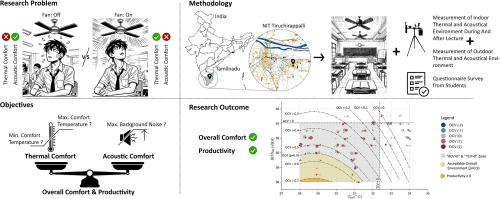热环境和声环境对印度自然通风大学教室整体舒适度和生产率的综合影响
IF 7.1
1区 工程技术
Q1 CONSTRUCTION & BUILDING TECHNOLOGY
引用次数: 0
摘要
吊扇通常用于气候温暖潮湿的自然通风教室,以确保热舒适度。但是,吊扇的转速越高,背景噪声就越大,从而影响声学舒适度。有关教室热舒适度和声舒适度的研究大多集中在热环境或声环境方面。虽然大多数关于热声环境综合影响的研究都是在气候箱中进行的,但并不能反映温暖潮湿气候下的温度和相对湿度范围。作者最近的研究考察了吊扇造成的不均匀环境对演讲厅热舒适度和声舒适度的影响。在这些研究的基础上,我们对实际教育环境中热环境和声环境对整体舒适度的综合影响进行了详细分析。研究包括对室内热和声学变量的现场测量,以及评估学生主观反应的综合问卷调查。在四个月的时间里,共收集了 11 个报告厅的 828 份学生问卷。采用回归分析法对热舒适度和声学舒适度数据进行了综合分析。据报告,在 27.8-29.8 °C、背景噪声为 56 分贝的环境中,学生的学习效率较高。在 28.8 °C、背景噪声高达 59.9 dBA 的条件下,学生可以接受的环境温度范围在 26.1 至 31.5 °C、56 dBA 之间。在 61 分贝时,整体舒适度可推断到 33.4 °C,但当背景噪声增加到 65 分贝时,阈值略微下降到 32.5 °C。这些研究结果可用于优化阶梯教室的室内环境,提高学生的学习效率。本文章由计算机程序翻译,如有差异,请以英文原文为准。

The combined influence of thermal and acoustic environment on overall comfort and Productivity in naturally ventilated university classrooms in India
Ceiling fans are commonly used in naturally ventilated classrooms in warm and humid climates to ensure thermal comfort. However, using ceiling fans at higher speeds increases background noise, interfering with acoustic comfort. Most research on thermal and acoustic comfort in classrooms focused on either thermal or acoustic environments. While most of the research on the combined influence of thermo-acoustic environments conducted in climate chambers, did not reflect ranges of temperature and relative humidity experienced in warm and humid climates. Recent studies by the authors have examined the effects of non-uniform environment created by ceiling fans on thermal and acoustic comfort in lecture halls. Building upon these studies, detailed analyses were carried out of the combined effects of thermal and acoustic environments on overall comfort in real educational settings. The research involved on-site measurements of indoor thermal and acoustic variables, along with a comprehensive questionnaire survey assessing students’ subjective responses. In total, 828 student responses were collected across 11 lecture halls over four months. Thermal and acoustical comfort data were analysed together using regression analysis. Higher productivity was reported within 27.8–29.8 °C at 56 dBA background noise. Students accepted the environment with background noise up to 59.9 dBA at 28.8 °C, and the acceptable temperature range varied between 26.1 and 31.5 °C at 56 dBA. Overall comfort was inferred up to 33.4 °C at 61 dBA, but this threshold slightly decreased to 32.5 °C when background noise increased to 65 dBA. These findings can be applied to optimize the indoor environment of lecture halls and increase students' productivity.
求助全文
通过发布文献求助,成功后即可免费获取论文全文。
去求助
来源期刊

Building and Environment
工程技术-工程:环境
CiteScore
12.50
自引率
23.00%
发文量
1130
审稿时长
27 days
期刊介绍:
Building and Environment, an international journal, is dedicated to publishing original research papers, comprehensive review articles, editorials, and short communications in the fields of building science, urban physics, and human interaction with the indoor and outdoor built environment. The journal emphasizes innovative technologies and knowledge verified through measurement and analysis. It covers environmental performance across various spatial scales, from cities and communities to buildings and systems, fostering collaborative, multi-disciplinary research with broader significance.
 求助内容:
求助内容: 应助结果提醒方式:
应助结果提醒方式:


